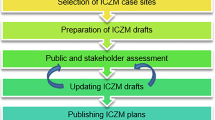Abstract
The Venice Lagoon (VL) is a complex ecosystem in which public participation and area-based management has often been neglected by administrative bodies involved in the planning of coastal projects and public works. In this area, the analysis of the local situation highlighted a substantial absence of coordination among the various administrative bodies in charge of planning and management at various governmental levels and in different regulated economic sectors. This paper analyses public participation and collaboration with reference to the Integrated Coastal Management context (ICM). The paper examines specific requirements, constraints, and opportunities for the complex case of the VL where participatory management and institutional coordination need enhancement.
Similar content being viewed by others
References
A. Bettinetti P. Pypaert J.-P. Sweerts (1996) ArticleTitleApplication of an integrated management approach to the restoration project of the Lagoon of Venice Journal of Environmental Management, 46 207–227
Bettiol, C., F. Collavini, S. Guerzoni, E. Molinaroli, P. Rossini, L. Zaggia & R. Zonta (this issue). Relative contribution of atmospheric and riverine inputs of metals, nutrients and POPs into the Lagoon of Venice
B. Bower C. H. Ehler D. Basta (1994) A Framework for Planning for Integrated Coastal Zone Management. NOAA/NOS Office of Ocean Resources Conservation and Assessment Silver Spring Maryland
Brochier, F. & C. Giupponi, 2001a. Integrated coastal zone management in the Venice area: potentials of the integrated participatory management approach. Note di lavoro Series, no. 99, 2001, 1–14
Brochier, F. & C. Giupponi, 2001b. Integrated coastal zone management in the Venice area: a methodological framework. Note di lavoro Series, no. 100, 2001, 1–17
Burigana, E., C. Giupponi, G. Bendoricchio, 2003. Nitrogen surplus as indicator of agricultural pollution impact in the Venice Lagoon watershed. Diffuse Pollution Conference, Dublin, 6-171-6-176
B. Cicin-Sain R. W. Knecht (1998) Integrated Coastal and Ocean Management: Concepts and Practices Island Press Washington D.C
EC, 1999a. EC Demonstration Programme on ICZM – Report of thematic study D, planning and management processes: sectoral and territorial cooperation, European Commission, University of Newcastle
EC, 1999b. Towards a European Integrated Coastal Zone Management (ICZM) Strategy: General Principles and Policy Options. A reflection paper. Directorates-General Environment; Nuclear Safety and Civil Protection; Fisheries; and Regional Policies and Cohesion
EC, 2000. An assessment of the socio-economic costs and benefits of Integrated Coastal Zone Management – Final report. Firn Crichton Roberts Ltd. and the Graduate School of Environmental Studies at the University of Strathclyde
EUCC, 1999. European code of conduct for coastal zones, CO-DBP(99)11, 3rd meeting, Geneva
Favero, V., 1992. Evoluzione morfologica e trasformazioni ambientali dalla conterminazione lagunare al nostro secolo. In: Conterminazione lagunare: storia, ingegneria, politica e diritto nella Laguna di Venezia. Proceedings of the Conference “Convegno di studio bicentenario della con terminazione lagunare”, 14–16 March, 1991, Venezia
S. Guerzoni S. Raccanelli (2004) The Sick Lagoon: Dioxin and Other Persistent Organic Pollutants (POPs) in the Lagoon of Venice Libreria Editrice Cafoscarina Venice, Italy
InstitutionalAuthorNameIPCC (1996) Climate change 1995, impacts, adaptations and mitigation of climate change: scientific-technical analysis R.T. Watson M.C. Zinyowera R.H. Moss (Eds) Contribution of Working Group II to the Second Assessment Report of IPCC Cambridge University Press Cambridge, UK
Musu, I., E. Ramieri, R. Cogo, 1998. Indicatori di sostenibilità: uno strumento per l’Agenda 21 a Venezia, Fondazione ENI Enrico Mattei Publication
Neil D. T., 2002. A thousand years of human-coastal interactions in Venice: lesson from the Serene Republic. Coast to Coast, 318–321
Orbach M., 1995. Social scientific contributions to coastal policy making. In: Improving Interactions between Coastal Science Policy. Proceedings of the California Symposium 49–59. Washington, D.C. National Academy Press
Provincia di Venezia, 2004. Calcolo dell’impronta ecologica e della biocapacità della Provincia di Venezia, 40 pp (in Italian)
Ramieri, E., 1999. Indicators of sustainable development for the city and the Lagoon of Venice, Fondazione ENI Enrico Mattei Publication
O. Ravera (2000) ArticleTitleThe Lagoon of Venice: the result of both natural factors and human influence Journal of Limnology, 59 19–30
Runca, E., A. Bernstein, L. Postmaand & G. Di Silvio, 1993. Control of macroalgae blooms in the Lagoon of Venice. Proc. MEDCOAST‚ 93 Conference, November 2–5, 1993, Antalya, Turkey
Smart, M. & V. Vinals, 2004. The Lagoon of Venice as a Ramsar Site. Provincia di Venezia
Sorensen, J. C. & S. T. McCreary, 1990. Institutional arrangements for managing coastal resources and environments. Renewable Resources Information Series, Coastal Management Publication No.1, National Park Service U.S. Department of the Interior and U.S. Agency for International Development
Sors, J. C., 2001. Measuring progress towards sustainable development in Venice: a comparative assessment of methods and approaches. Note di lavoro Series, no. 16, 1–29
G. Umgiesser D. Melaku Canu C. Solidoro R. Ambrose (2003) ArticleTitleA finite element ecological model: a first application to the Venice Lagoon Environmental Modelling & Software 18 131–145
UNESCO, 1995. La Laguna di Venezia, Cierre (ed.)
UNESCO, 2004. “The Operational Guidelines for the Implementation of the World Heritage Convention”. Found at http://whc.unesco.org/pg.cfm?cid57
M. Wackernagel W Rees (1996) Our ecological footprint- Reducing human impact on the Earth New Society Publisher Canada
WCC, 1993. Preparing to meet the coastal challenges of the 21st Century. Conference report, World Coast Conference, November, 1–5, 1993, Noordwijk, The Netherlands. The Hague: Ministry of Transport, Public Works, and Water Management
Author information
Authors and Affiliations
Corresponding author
Rights and permissions
About this article
Cite this article
Suman, D., Guerzoni, S. & Molinaroli, E. Integrated coastal management in the Venice lagoon and its watershed. Hydrobiologia 550, 251–269 (2005). https://doi.org/10.1007/s10750-005-4393-x
Issue Date:
DOI: https://doi.org/10.1007/s10750-005-4393-x




